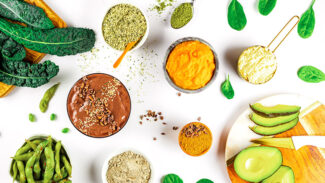Hiya Gorgeous,
If I had a dollar for every time I’ve been asked, “What’s the difference between juicing and blending?” I could open an animal sanctuary and pay for you all to come and visit!
I began incorporating both juices and smoothies into my diet over 16 years ago when my cancer diagnosis had me searching for ways to give my body the support and nutrition it needed. Juicing and blending became—and have remained—staples in my feel-great plan ever since. They’re also important parts of the wellness plans I create, such as Crazy Sexy You (my 21-day total wellness program).
And while these practices have become increasingly popular in the last several years, some of you may still be confused about their differences and benefits. Each method has its unique perks, but rest assured they’re both fabulous ways to incorporate nutrition-packed produce into your diet.
The Benefits of Juicing
Juicing extracts the liquid from the fruits and vegetables, leaving the majority of the fiber behind. By removing the fiber, all of the nutrients in the plant’s juice—vitamins, minerals, enzymes—instantly flood our bodies with goodness, especially when enjoyed first thing in the morning before any other food hits your system. Just think of the added volume of veggies you can pack in your belly, sweet unicorn! Even those of us with the heartiest of appetites would find it challenging to consume the same amount of raw vegetables and fruits with a fork.
Juices also give your digestive system a little rest by removing most of the fiber (which takes a lot of energy to digest). Since your body works hard on your behalf 24/7, it’s nice to give it some R&R. That’s not to say you should avoid fiber—it’s super important for you and helps keep ya regular. But if you’re upgrading your overall diet to include lots of plant-based, whole foods, you’ll be getting plenty of it, especially if you include smoothies and healthy, home-cooked chow.
Got digestive ouchies? Juicing is a great option for folks whose digestive systems are too sensitive to handle lots of fiber, or for those getting used to a plant-rich diet. If that’s you, juicing ensures you can enjoy the benefits of boatloads of awesome produce without suffering any tummy troubles for your efforts. For people focused on healing or repair in general, juices offer maximum health benefits in a gentle, easy-to-digest, easy-to-assimilate form. I’ve also heard that some folks get turned off by the texture of smoothies. If that’s you, then juicing is a fantastic option!
Keep in mind that green juices aren’t complete meals, whereas smoothies can be. Some folks enjoy a green juice first thing in the morning or for an afternoon pick-me-up. If you have a juice in the morning and don’t want a full meal right away, make sure to grab a hearty mid-morning snack to keep your energy up. If you want your afternoon green juice to have more staying power, enjoy it with a handful of nuts or seeds. This will help you make sure you’re getting all of the essential nutrients you need, including the protein and fiber juices don’t include.
To ensure your green juices aren’t too high in fruity sugar, use three servings of veggies for every one serving of fruit. Or go veggie crazy and just use some lemon, lime, ginger, carrots or romaine to add tangy sweetness to your drinks. The lower the sugar, the more effective the green juice will be at boosting your immune system and fighting inflammation.
The Benefits of Green Smoothies
Blending on the other hand… blends! The ingredients are whirled and pureed into scrumptious smoothies that provide the benefits of fruits and veggies along with their heart-healthy, gut-friendly fiber. Folks who are watching their blood sugar sometimes prefer blending to juicing because the fiber ensures a slow and steady absorption of sugar into your bloodstream.
Besides all the great fiber, smoothies allow you to use fantastic foods that juicers can’t always handle. Take sprouts, for instance—those tiny powerhouses of plant nutrition. Sprouts will shoot right through a centrifugal juicer without getting juiced, but they blend up perfectly in smoothies. Nut butters and superfood powders can give you (and your energy levels) a powerful boost, but they can’t be juiced. Blend them up, though, and you’re on your way to all sorts of flavorful and even medicinal drinks.
Smoothies have another important advantage: They can help you feel fuller longer. Protein, fiber, healthy fats and complex carbs create sustainable energy. If you fill up your smoothies with lots of nutrient-packed ingredients, they can even serve as well-rounded, convenient and delectable meals. Plus, they support healthy digestion because of the fiber and other nutritious ingredients.
When blending up your delish smoothies, include at least one veggie for every two fruits. Start with a tightly packed cup of leafy greens like spinach or kale, and add a cup of frozen fruit (such as frozen berries or mango, or raw fruit plus a cup of ice) and a banana or avocado for creaminess. Then pour in your liquid of choice (unsweetened nondairy milk, water, coconut water, etc.), filling the blender up to the level of the other ingredients. If you’re feeling adventurous, sneak in a tablespoon or two of hemp seeds, almond butter or other nuts/seeds for protein, and top it off with bonus superfoods like matcha, cacao, maca, spirulina or chia seeds. Blend and go! This formula will serve one to two people depending on appetite.










Hi Kris,
Thanks for this concise summary. I’ve gone back and forth as to whether juicing is a good idea or not, and sometimes all the conflicting information out there can be confusing, but you’ve done a good job of highlighting the pros and cons of both. I don’t have a juicer, but I do drink a green smoothie pretty much every day. And when I say green, I mean GREEN!
Hi Kris,
Wondering if there are different recipes in your Crazy Sexy Diet book compared to Crazy Sexy Kitchen book?
Thank you!! You’re the best. Love your attitude!!
Heather
Great question, Heather. Crazy Sexy Diet outlines my plant-based philosophy and also includes a cleanse with some recipes and meal suggestions. Crazy Sexy Kitchen is a straight up cookbook, with tons of recipes for every meal, snacks, desserts and so on–though I do go through an overview of my plant-based living there too. I basically teach whenever I can! In Crazy Sexy Juice as well. Thanks for asking. xo kc
Kris you never cease to amaze and inspire me! Thank you for this great info. I have been juicing and blending for years and attribute my continued good health with stage 4 cancer to my morning concoctions. In the past year I have been using my juice as the liquid for my blended drinks and man does my body seem to love all of that incredible goodness to start the day!! Because it is all rather labour intensive, I make a big batch all at once and fill mason jars and freeze them. I know fresh is best but this way I get to enjoy the benefits without cleaning out my Vitamix and juicer every day. I love knowing my super drink is always available in my fridge! I just take the next day’s out of the freezer to thaw in the fridge when I drink my morning drink packed with about a dozen fruits and veggies in balance per concoction! Tastes yummy and makes me feel zippy all day.
I do the same thing when I’m super busy, Nancy! You’re so smart. Thanks for your comment. And keep on kicking ass! xo kc
I do both. I have used the pulp from the juicing to make veggie burgers. Still perfecting that art. Great article though. I never thought of it as removing all the fiber and that is good to know. My mother has pancreatic cancer and too much fiber throws her system out of whack, so I will recommend juicing to her for now.
Wonderful Pia. xo
I had a question about some advice you give in Crazy Sexy Diet. You suggest to only drink juice or smoothies until noon. What is the reason behind this suggestion? I am not sure that’s possible for me because of the job I have, so i was just curious about the reasoning so I can make an informed decision about what to do for myself. Thanks
Hi Alissa,
During the cleanse some people experience great benefits from keeping it really light in the morning, it’s almost like extending the fast from the night before, which gives your body a longer break. Juice and smoothies are very easy to digest. However, when you’re not cleansing or if that just doesn’t work for you, it’s beyond fine to include more food in the morning. Some folks who struggle with energy and/or blood sugar roller coasters may not do well with only juice or smoothies for breakfast. Everyone is different and oh so wonderfully unique. Do what works for you. Include your juice or smoothie and then add oatmeal or avocado toast or whatever healthy fuel you love. Hope that helps! xo kc
Hi Kris
Great article and as a result I have just pre ordered your book on Amazon (UK)!
Can’t wait
Thank you for this brilliant summary! People often ask me and now I have the perfect go to resource for them! I’ve been a big fan of juice since my husband was diagnosed with cancer 10 years ago. Juicing was a big part of his wellness plan to get thru hi dose chemo and stem cell transplants. During that time we felt fantastic due to all of the deliciousness we were getting from juice. I still love a green juice to pick me up and leave me alkalized. Thank you for creating fabulous concise resources that provide actionable plans for those wanting to understand and take their health to the next level.
Thanks Leanne! You’re inspiring lady.
I really tried to reduce sugar after my diagnosis, so I decided I would eat whole fruits (or blend them into a smoothie), while juicing organic vegetables to get as many vegetables and anti-cancer compounds in my cup as possible. My favorite juices were spinach/cucumber/celery, plain celery, and beet/carrot/ginger (that last one has a lot of sugars but also huge amounts of natural beta carotene and major liver-boosting power from beets – much better for me than juicing apples, I think).
Edit: I even blogged about this a few weeks ago, with more on my rationale and why I chose juicing for veggies and smoothies for fruits (or just eating the fruits). It’s here: http://pandorashealth.com/2015/09/25/why-i-juice-veggies-not-fruits/
I’m close to entering my 8th year of daily juicing(and being cancer free) and it’s all because of you, Kris! Thank you SO much for all your hard work and years of inspiration !
Congrats Benita, you’re amazing! xo
Hi Kris, I’m looking for a Wide mouthed Juicer, have an Omega 8003 small mouthed but need an easier one for carrots, beets. What kind is the one in picture off to side showing wide mouth and will it take these veg. AND greens?
Thanks , Carole
Hi Carole, it’s a Breville Ikon. xo!
I really appreciate the discussion regarding the difference. Good job!
Hi Kris, loving your books! I am from the UK. I have CS Kitchen and CS Diet and have pre-ordered CS Juice. So looking forward to the 3 day cleanse. I have been following you for a while now and everything you say makes complete sense. I’m not sure how humans have become so mixed up about food and are now in a terrible situation where we are just eating a bunch of chemicals and bad fats all mixed up to make something we call ‘yummy’. How crazy is that?!!! I get so mad when I walk into the supermarket and see peoples’ trolleys laden with different shaped sugar and hydroginated fat items in different coloured packaging enticing us in….. Some even claim to be ‘healthy’! It is a very sad state of affairs. I think your books are very clear and have been so helpful in explaining everything and weeding out what we have been brought up to believe was ‘healthy food’. I feel free to make the right choices now. Thank you so much. To answer your question – I tend to have smoothies for breakfast as they keep me going for longer and then I have green juice when I get in from work, and then supper two hours later. Lunch and supper consist of a rainbow of veg plus seeds/nuts/pulses with a drizzle of flax oil and apple cider vinegar. I have raw oats about 3 times per week but no other grains or refined carbs. I have been veggie for 30 years but since reading your books, have decided to go vegan. So liberating! I need to shift about 40lbs. (10lbs has gone in the last month – with very little effort). Thank you , thank you, thank you – and keep writing! Love Sally xxx
Thanks for going into detail about the differences between the two. I conducted some research a few years ago on the differences, however I’m always eager to learn more. I definitely prefer smoothies and as I type I have a green smoothie (kale, pear, lemon, flax seed, hemp hearts and coconut water) by my side.
I juice from time to time but have realized I have to have a lot of fruit on hand to get a decent amount produced to drink, while with smoothies I find it fills me up more. I will continue to do both, but prefer smoothies:)
I drink more smoothies because the budget to this point dictated that I choose a blender or juicer and not both. I went with the blender because the juicer also requires the purchase of much more produce than the smoothies. A juicer is on the wish list for when I’m in better shape financially 🙂 In the meantime, we’re blessed here in Boulder with places to get green juice for we juicer-deprived souls!.
Hey Kris!
We definitely drink more smoothies in our house, but I would like to make more juice!! I just purchased your new book and I can’t wait to try out the recipes! Now if only I could make more time in the morning to make sure I drink one every day….
Hello Kris,
I just pre-ordered Crazy Sexy Juice! I am very excited to receive it. 🙂 Thank you so much for the very nice & fun freebies!!!!!
Teresa
Thanks for this summary! In your opinion, which are some of the best juicers out there?
For what it’s worth, I’ve been using an Omega J8006 weekly for 2 years now. The J8003 is quite a bit less $, but essentially the same juicer. I LOVE IT! The difference in the juice from this type of juicer compared to the high-speed, high-heat centrifugal juicers is worlds apart. Especially if you intend to juice greens.
Hi Vivian!
There are lots of wonderful juicers out there to fit all kinds of lifestyles, needs and budgets! Here are some great ones to look into:
Centrifugal juicers: Breville Ikon Multi-Speed, Breville Juice Fountain Compact (a smaller juicer, great for apartment living), and the Omega 4000. Masticating juicers: Hurom Slow Juicer (my personal favorite, which includes a 10-year warranty), Omega 8006 Nutrition System Juicer, Omega VRT350, Breville Fountain Crush Slow Juicer, Champion Household Juicer. Twin gear juicers: Super Angel 5500, Samson Green Power, Green Star Elite Juice Extractor.
Centrifugal = fast, easy, kind of loud, juice oxidizes faster than it would with slower-speed juicers
Masticating = typically more juice yield than centrifugal, less oxidation, quiet, more prep, slower process, can be pricey
Twin gear = highest yield, least oxidation, more prep, slower process, can be pricey
And look out for my blog that walks you through exactly how to pick a juicer and all the factors involved—coming in the next few weeks! 🙂
I use a vita-mix, so I only blend. Been using it for 18 years now. Looking forward to receiving your new book, I read therefore I cook. Thanks for all of your recipes and a healthy way of eating.
Thank you for this thorough explanation. Your passion shines in every sentence of your blog post 🙂 You have inspired me to eat a plant-based diet in your talks and videos. Thank you 🙂
I fall on the blender/smoothie side because of exactly what you mention — blood sugar spikes. For the overdose of fiber, I add probiotics and digestive enzymes. I really like to take the juice recipes and find a blend/smoothie alternative though. It’s my own science experiment!